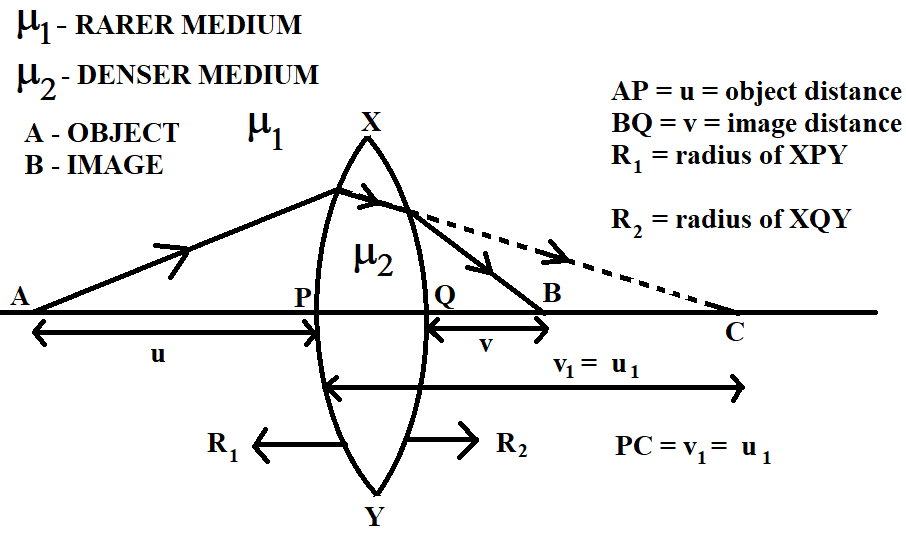
Derive Lens Maker’s formula for a convex lens.
Answer
500.1k+ views
Hint: A convex lens or a biconvex lens has two convex surfaces. We use the formula for refraction through convex surfaces to both these convex surfaces and add them, to derive the Lens Maker’s formula. Refraction through a convex surface is dependent on the nature of the medium as well as the radius of curvature of the surface, through which refraction takes place.
Complete step by step answer:
Let us consider a convex lens as shown in the figure. It consists of two convex surfaces
Usually, when we use a lens, the medium inside the lens turns out to be denser than the surrounding medium. Therefore, let us consider

Firstly, let us consider refraction through the convex surface
where
Let this be equation 1.
Applying equation 1 to the case of refraction through
where
Let this be equation 2.
Now, let us move on to the refraction happening through the other convex surface of the lens,
We also assume that the refraction happening here is from denser medium to rarer medium, as if the object is placed in denser medium. After refraction
where
Let this be equation 3.
Applying equation 3 to the case of refraction through
where
Let this be equation 4.
Now, to get the combined refraction through both the convex surfaces, as if the case of refraction through a convex lens, let us add equation 2 and equation 4. We have
Let this be equation 5.
Here, we know that
Therefore, equation 5 becomes
Taking
We know that
where
We also know that
where
Substituting these values in the above expression, we have
Let this be equation 6.
Equation 6 is nothing but Lens Maker’s formula. Explaining the terms in Lens Maker’s formula, we have
where
Hence, the derivation.
Note:
Refraction through convex surfaces follows sign convention. For convenience, parameters on the left side of the surface are taken as negative and the parameters on the right side of the surface are taken as positive. Clearly, object distances in the first case as well as the second case are taken as negative and the corresponding image distances turn out to be positive. Since the radius of curvature falls on the right side in each case of refraction, it is taken to be positive always. This sign convention is followed throughout this writeup and can be clearly seen in equation 2 as well as equation 3.
Complete step by step answer:
Let us consider a convex lens as shown in the figure. It consists of two convex surfaces
Usually, when we use a lens, the medium inside the lens turns out to be denser than the surrounding medium. Therefore, let us consider

Firstly, let us consider refraction through the convex surface
where
Let this be equation 1.
Applying equation 1 to the case of refraction through
where
Let this be equation 2.
Now, let us move on to the refraction happening through the other convex surface of the lens,
We also assume that the refraction happening here is from denser medium to rarer medium, as if the object is placed in denser medium. After refraction
where
Let this be equation 3.
Applying equation 3 to the case of refraction through
where
Let this be equation 4.
Now, to get the combined refraction through both the convex surfaces, as if the case of refraction through a convex lens, let us add equation 2 and equation 4. We have
Let this be equation 5.
Here, we know that
Therefore, equation 5 becomes
Taking
We know that
where
We also know that
where
Substituting these values in the above expression, we have
Let this be equation 6.
Equation 6 is nothing but Lens Maker’s formula. Explaining the terms in Lens Maker’s formula, we have
where
Hence, the derivation.
Note:
Refraction through convex surfaces follows sign convention. For convenience, parameters on the left side of the surface are taken as negative and the parameters on the right side of the surface are taken as positive. Clearly, object distances in the first case as well as the second case are taken as negative and the corresponding image distances turn out to be positive. Since the radius of curvature falls on the right side in each case of refraction, it is taken to be positive always. This sign convention is followed throughout this writeup and can be clearly seen in equation 2 as well as equation 3.
Recently Updated Pages
Master Class 12 Business Studies: Engaging Questions & Answers for Success

Master Class 12 English: Engaging Questions & Answers for Success

Master Class 12 Social Science: Engaging Questions & Answers for Success

Master Class 12 Chemistry: Engaging Questions & Answers for Success

Class 12 Question and Answer - Your Ultimate Solutions Guide

Master Class 11 Economics: Engaging Questions & Answers for Success

Trending doubts
Draw a labelled sketch of the human eye class 12 physics CBSE

a Tabulate the differences in the characteristics of class 12 chemistry CBSE

Which one of the following is a true fish A Jellyfish class 12 biology CBSE

Why is the cell called the structural and functional class 12 biology CBSE

Differentiate between homogeneous and heterogeneous class 12 chemistry CBSE

Write the difference between solid liquid and gas class 12 chemistry CBSE




